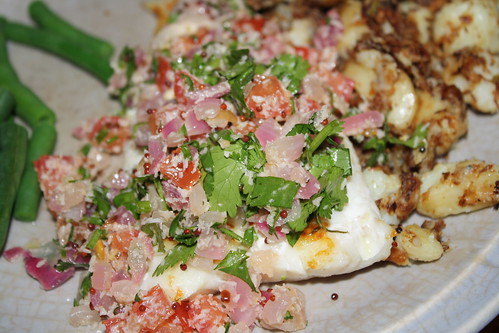We try to eat fish at least once a week and, I have to confess, I really struggle with making sustainable fish choices outside farmed salmon. I want to choose fish which is fresh, local and sustainable – especially when a recipe calls for a firm white fish. We all love flathead but not only is this a bad choice, it’s also stupidly expensive. And sometimes (as in, a Sunday afternoon after a couple of hours at a 3 year old’s birthday party) your choice is dictated by what’s in the supermarket.
Anyway, the happy outcome of this story is that the following sambal would work brilliantly with other proteins. A tandoori lamb chop, a chicken breast, or even snuck into a chicken burger. Or on top of some fish, if you can find something that ticks all the boxes.
Don’t be put off by the fact that the following recipe contains coconut. It’s essential, more for texture than flavour. If you have access to fresh grated coconut, even better, but dessicated will do (I’m testament to that!).
The sambal can be prepared in advance (and I suspect this would improve it) and can be tweaked to suit your preference. Just don’t go overcomplicating things.
I served the sambal on top of the pan fried fish, with steamed green beans and a generous side portion of spicy fried potatoes. Even with the potatoes this is a very healthy dinner.
The original recipe comes from taste.com.au.
Ingredients
- ½ small brown onion, finely chopped
- ½ red onion, finely chopped
- 1 tsp fresh ginger, grated
- 1 tsp black mustard seeds
- ~ ¼ cup of coconut - either dessicated or shredded fresh
- fresh green chilli, finely chopped, to taste
- 1 tomato, finely chopped (deseeded, if you can be bothered!)
- generous handful of coarsely chopped fresh coriander
- 1 tbsp lemon juice
- 1 pinch caster sugar
Instructions
- On a mediuam heat, heat some oil (I used peanut) in a pan, and add the onion. When the onion starts to soften, add the ginger and mustard seeds.
- When the onion is soft, add the coconut and toast until the coconut just starts to change colour. You need to pay attention here because burnt coconut will taste awful and you won't be able to rectify things!
- Place the chilli in a small bowl. Tip over the hot onion and stir through. Allow to cool slightly before adding the tomato, coriander, lemon juice and sugar. Mix well. Taste and correct seasoning (you may want to add salt) if necessary.
- If you're making in advance, store in the fridge, but serve at room temperature.

